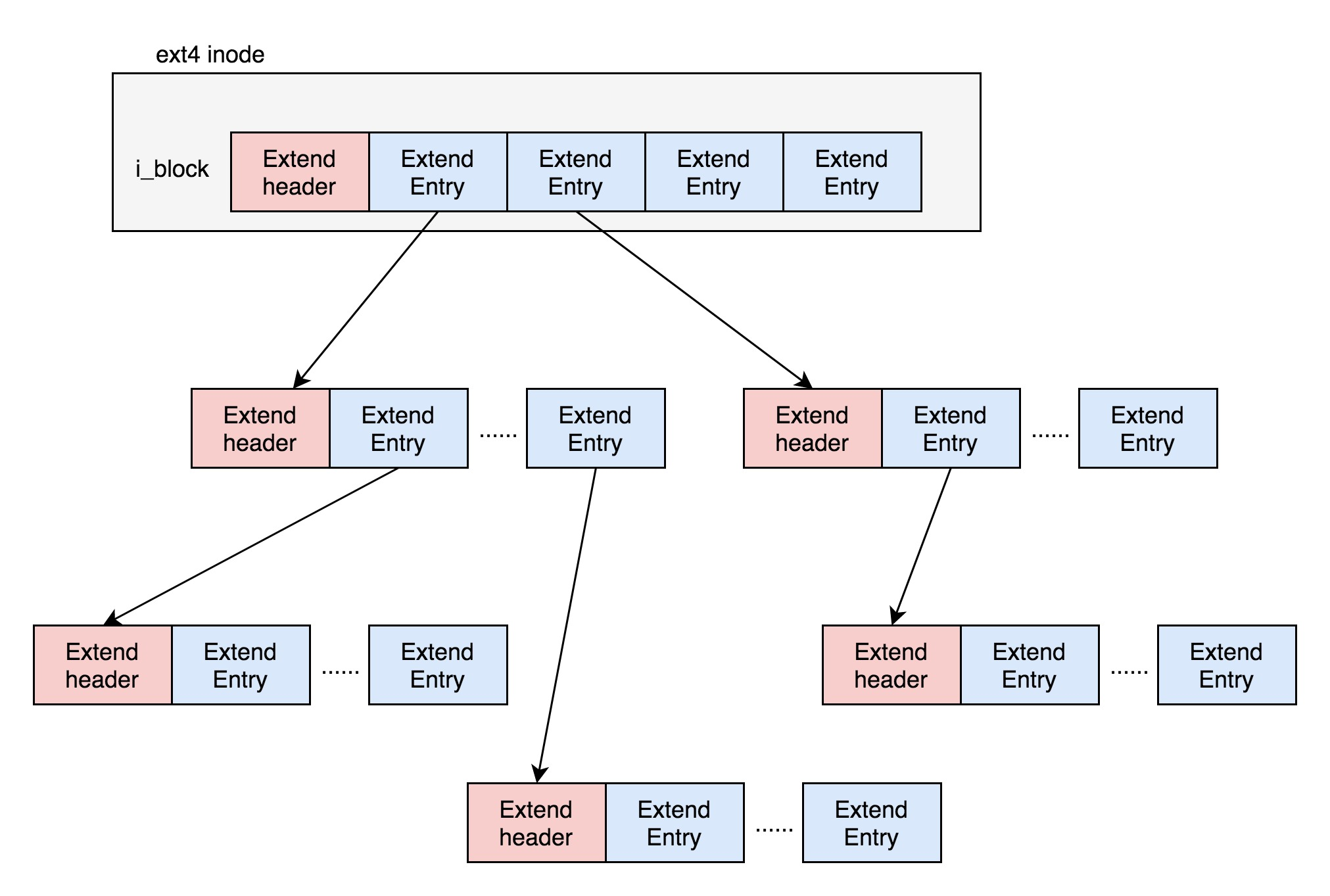我在学习研究Linux内核结构的时候,思考过一个问题:Linux如何定位文件在磁盘的物理位置
每个文件都有一个inode,inode在内核代码中的数据结构如下:
1 struct ext4_inode { 2 __le16 i_mode; /* File mode */ 3 __le16 i_uid; /* Low 16 bits of Owner Uid */ 4 __le32 i_size_lo; /* Size in bytes */ 5 __le32 i_atime; /* Access time */ 6 __le32 i_ctime; /* Inode Change time */ 7 __le32 i_mtime; /* Modification time */ 8 __le32 i_dtime; /* Deletion Time */ 9 __le16 i_gid; /* Low 16 bits of Group Id */ 10 __le16 i_links_count; /* Links count */ 11 __le32 i_blocks_lo; /* Blocks count */ 12 __le32 i_flags; /* File flags */ 13 ...... 14 __le32 i_block[EXT4_N_BLOCKS];/* Pointers to blocks */ 15 __le32 i_generation; /* File version (for NFS) */ 16 __le32 i_file_acl_lo; /* File ACL */ 17 __le32 i_size_high; 18 ...... 19 };
我们说的“某个文件分成几块、每一块在哪里”,这些在 inode 里面,应该保存在 i_block( i_block[EXT4_N_BLOCKS];/* Pointers to blocks */)里面
为了解决ext2和ext3文件系统大文件读写性能低下的问题,ext4 做了一定的改变。它引入了一个新的概念,叫作 Extents。我们来解释一下 Extents。比方说,一个文件大小为 128M,如果使用 4k 大小的块进行存储,需要 32k 个块。如果按照 ext2 或者 ext3 那样散着放,数量太大了。但是 Extents 可以用于存放连续的块,也就是说,我们可以把 128M 放在一个 Extents 里面。这样的话,对大文件的读写性能提高了,文件碎片也减少了。
Exents 如何来存储呢?它其实会保存成一棵树。

树有一个个的节点,有叶子节点,也有分支节点。每个节点都有一个头,ext4_extent_header 可以用来描述某个节点
struct ext4_extent_header { __le16 eh_magic; /* probably will support different formats */ __le16 eh_entries; /* number of valid entries */ __le16 eh_max; /* capacity of store in entries */ __le16 eh_depth; /* has tree real underlying blocks? */ __le32 eh_generation; /* generation of the tree */ };
我们仔细来看里面的内容。eh_entries 表示这个节点里面有多少项。这里的项分两种,如果是叶子节点,这一项会直接指向硬盘上的连续块的地址,我们称为数据节点 ext4_extent;如果是分支节点,这一项会指向下一层的分支节点或者叶子节点,我们称为索引节点 ext4_extent_idx。这两种类型的项的大小都是 12 个 byte。
/* * This is the extent on-disk structure. * It's used at the bottom of the tree. */ struct ext4_extent { __le32 ee_block; /* first logical block extent covers */ __le16 ee_len; /* number of blocks covered by extent */ __le16 ee_start_hi; /* high 16 bits of physical block */ __le32 ee_start_lo; /* low 32 bits of physical block */ }; /* * This is index on-disk structure. * It's used at all the levels except the bottom. */ struct ext4_extent_idx { __le32 ei_block; /* index covers logical blocks from 'block' */ __le32 ei_leaf_lo; /* pointer to the physical block of the next * * level. leaf or next index could be there */ __le16 ei_leaf_hi; /* high 16 bits of physical block */ __u16 ei_unused; };
从上述数据结构中的ee_start_hi/ee_start_lo/ei_leaf_lo可以体现出物理块的指针。
参考文献:《趣谈Linux操作系统》 by 刘超
参考链接:https://blog.csdn.net/stringnewname/article/details/73740155